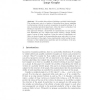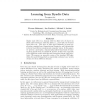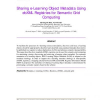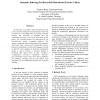2164 search results - page 293 / 433 » Learning to rank for information retrieval |
COLT
2004
Springer
15 years 3 months ago
2004
Springer
We consider the problem of labeling a partially labeled graph. This setting may arise in a number of situations from survey sampling to information retrieval to pattern recognition...
NIPS
1998
14 years 11 months ago
1998
Dyadic data refers to a domain with two nite sets of objects in which observations are made for dyads, i.e., pairs with one element from either set. This type of data arises natur...
ITIIS
2008
14 years 8 months ago
2008
To facilitate the processes of e-learning resource description, discovery and reuse, e-learning objects should be appropriately described and classified using standard metadata th...
PERCOM
2006
ACM
15 years 9 months ago
2006
ACM
In this paper, we present a general architecture and a new retrieval method for an educational system that is based on a knowledge base of existing recorded lectures. The extracti...
SIGIR
2002
ACM
14 years 9 months ago
2002
ACM
Most test collections (like TREC and CLEF) for experimental research in information retrieval apply binary relevance assessments. This paper introduces a four-point relevance scal...




